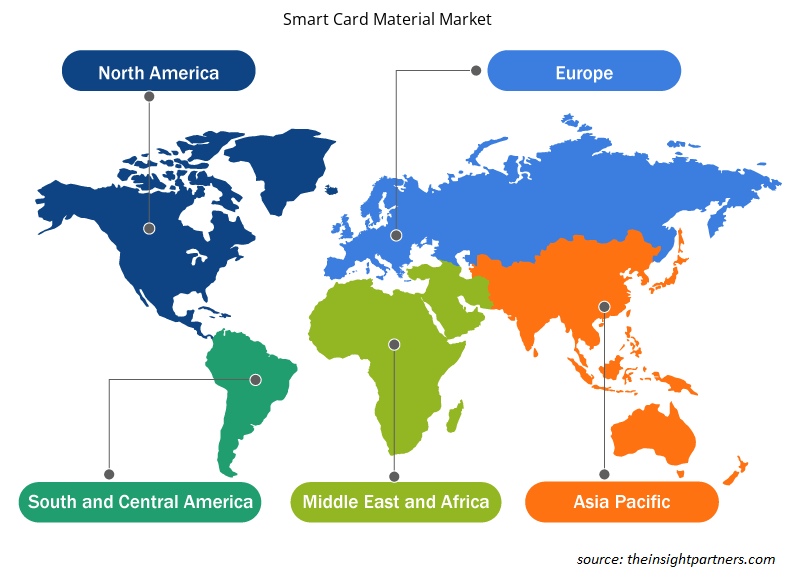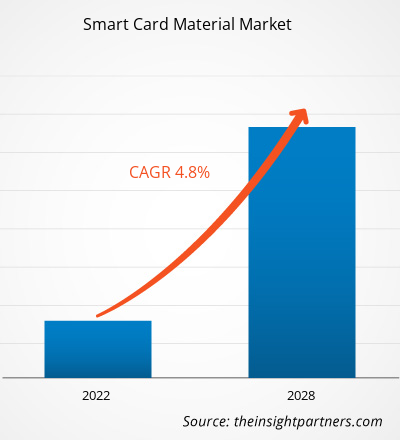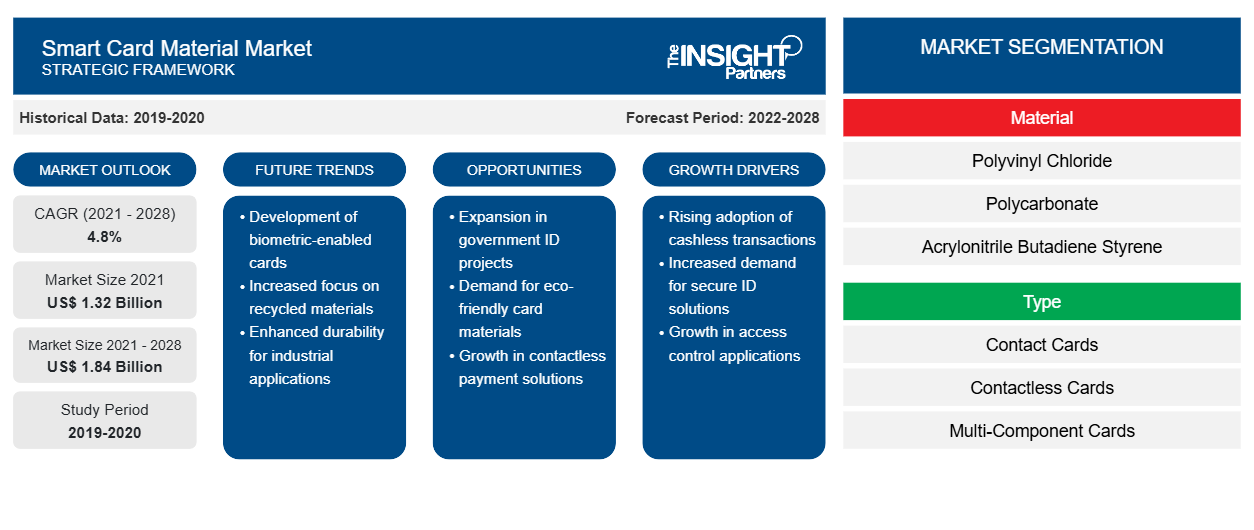Le marché des matériaux pour cartes à puce devrait atteindre 1 837,78 millions USD d'ici 2028, contre 1 324,57 millions USD en 2021 ; il devrait croître à un TCAC de 4,8 % de 2021 à 2028.
Une carte à puce, un type de carte à puce, est une carte en plastique qui contient une puce informatique intégrée, de type mémoire ou microprocesseur, qui stocke et traite des données. Ces données sont généralement associées à une valeur ou à des informations, ou aux deux, qui sont stockées et traitées dans la puce. Les matériaux des cartes à puce font référence aux matériaux chimiques utilisés dans la fabrication de ces cartes. Ces matériaux permettent l'intégration et l'impression d'informations sur celles-ci.
En 2020, la région Asie-Pacifique détenait la plus grande part du marché mondial des matériaux pour cartes à puce . La demande de matériaux pour cartes à puce dans cette région augmente en raison de l'utilisation croissante des cartes à puce dans le secteur des télécommunications. En outre, la tendance croissante à la mondialisation et la prolifération du secteur bancaire, des services financiers et des assurances (BFSI) sont des facteurs clés favorisant la croissance du marché des matériaux pour cartes à puce dans la région.
Personnalisez ce rapport en fonction de vos besoins
Vous bénéficierez d'une personnalisation gratuite de n'importe quel rapport, y compris de certaines parties de ce rapport, d'une analyse au niveau des pays, d'un pack de données Excel, ainsi que d'offres et de remises exceptionnelles pour les start-ups et les universités.
-
Obtenez les principales tendances clés du marché de ce rapport.Cet échantillon GRATUIT comprendra une analyse de données, allant des tendances du marché aux estimations et prévisions.
Impact de la pandémie de COVID-19 sur le marché des matériaux pour cartes à puce
La pandémie de COVID-19 en cours a radicalement modifié le statut du secteur des produits chimiques et des matériaux et a eu un impact sur la croissance du marché des matériaux pour cartes à puce. La baisse significative des performances de plusieurs secteurs industriels a eu un impact sur la demande de matériaux pour cartes à puce. L'impact de la pandémie varie selon les différents segments d'application. Une augmentation du trafic de données et des services vocaux a profité à de nombreux acteurs des télécommunications, notamment aux opérateurs de centres de données à large bande et mobiles. Cependant, les mesures de confinement imposées par les gouvernements ont perturbé les chaînes d'approvisionnement en matières premières telles que le PVS, l'ABS et le PETG nécessaires à la fabrication de cartes à puce. La propagation de la maladie a eu un impact négatif sur les opérations des secteurs public et BFSI. Cependant, alors que les économies prévoient de relancer leurs opérations, la demande de matériaux pour cartes à puce devrait augmenter à l'échelle mondiale dans les années à venir.
Informations sur le marché
Croissance significative dans les secteurs des télécommunications et de la santé
Les cartes à puce sont largement utilisées dans le secteur des télécommunications. Les cartes à puce les plus utilisées dans ce secteur sont les cartes SIM (Subscriber Identity Module) ou les cartes à circuit intégré universelles (UICC). Ces cartes à puce sont principalement fabriquées à partir de matériaux en chlorure de polyvinyle (PVC) et en acrylonitrile butadiène styrène (ABS). La technologie des cartes à puce utilisée dans les applications de ce secteur a connu des progrès continus au cours des dernières années, ce qui a stimulé la consommation de ces cartes. En outre, les organisations de soins de santé du monde entier mettent en œuvre des cartes de santé à puce dotées d'un large éventail de fonctionnalités et d'applications.
Aperçu régional du marché des matériaux pour cartes à puce
Les tendances et facteurs régionaux influençant le marché des matériaux pour cartes à puce tout au long de la période de prévision ont été expliqués en détail par les analystes d'Insight Partners. Cette section traite également des segments et de la géographie du marché des matériaux pour cartes à puce en Amérique du Nord, en Europe, en Asie-Pacifique, au Moyen-Orient et en Afrique, ainsi qu'en Amérique du Sud et en Amérique centrale.

- Obtenez les données régionales spécifiques au marché des matériaux pour cartes à puce
Portée du rapport sur le marché des matériaux pour cartes à puce
| Attribut de rapport | Détails |
|---|---|
| Taille du marché en 2021 | 1,32 milliard de dollars américains |
| Taille du marché d'ici 2028 | 1,84 milliard de dollars américains |
| Taux de croissance annuel moyen mondial (2021-2028) | 4,8% |
| Données historiques | 2019-2020 |
| Période de prévision | 2022-2028 |
| Segments couverts |
Par matériau
|
| Régions et pays couverts |
Amérique du Nord
|
| Leaders du marché et profils d'entreprises clés |
|
Densité des acteurs du marché des matériaux pour cartes à puce : comprendre son impact sur la dynamique commerciale
Le marché des matériaux pour cartes à puce connaît une croissance rapide, tirée par la demande croissante des utilisateurs finaux en raison de facteurs tels que l'évolution des préférences des consommateurs, les avancées technologiques et une plus grande sensibilisation aux avantages du produit. À mesure que la demande augmente, les entreprises élargissent leurs offres, innovent pour répondre aux besoins des consommateurs et capitalisent sur les tendances émergentes, ce qui alimente davantage la croissance du marché.
La densité des acteurs du marché fait référence à la répartition des entreprises ou des sociétés opérant sur un marché ou un secteur particulier. Elle indique le nombre de concurrents (acteurs du marché) présents sur un marché donné par rapport à sa taille ou à sa valeur marchande totale.
Les principales entreprises opérant sur le marché des matériaux pour cartes à puce sont :
- Société chimique Eastman
- Société à responsabilité limitée PetroChina
- Solvay SA
- KEM UN
- SABIC
Avis de non-responsabilité : les sociétés répertoriées ci-dessus ne sont pas classées dans un ordre particulier.

- Obtenez un aperçu des principaux acteurs du marché des matériaux pour cartes à puce
Informations sur les applications
En fonction des applications, le marché des matériaux pour cartes à puce est segmenté en BFSI, gouvernement, télécommunications, vente au détail, soins de santé, hôtellerie et autres. Le segment des télécommunications détenait la plus grande part du marché des matériaux pour cartes à puce en 2020. Les cartes à puce sont utilisées comme cartes téléphoniques prépayées (cartes mémoire à valeur stockée) et comme cartes SIM à base de cartes à puce à microprocesseur ou UICC dans les téléphones mobiles. Les produits de cartes à puce les plus vendus dans ce secteur sont les cartes SIM et UICC, en termes de volume et de valeur.
Quelques-uns des acteurs opérant sur le marché mondial des matériaux pour cartes à puce incluent Eastman Chemical Company, PetroChina Company Limited, Solvay SA, KEM ONE, SABIC, 3A Composites GmbH, Teijin Limited, LG Chem, BASF SE et Westlake Chemical Corporation.
Rapports en vedette
- Tendances industrielles progressistes sur le marché des matériaux pour cartes à puce pour aider les acteurs à développer des stratégies efficaces à long terme
- Stratégies de croissance des entreprises adoptées par les entreprises opérant sur les marchés développés et en développement
- Analyse quantitative du marché des matériaux pour cartes à puce de 2019 à 2028
- Estimation de la demande mondiale en matériaux pour cartes à puce
- Analyse des cinq forces de Porter pour illustrer l'efficacité des acheteurs et des fournisseurs opérant dans l'industrie
- Développements récents pour comprendre le scénario concurrentiel du marché
- Tendances et perspectives du marché ainsi que facteurs qui stimulent et freinent la croissance du marché des matériaux pour cartes à puce
- Aide au processus de prise de décision en mettant en évidence les stratégies de marché qui sous-tendent l'intérêt commercial, conduisant à la croissance du marché des matériaux pour cartes à puce
- La taille du marché des matériaux pour cartes à puce à différents niveaux
- Aperçu détaillé et segmentation du marché, ainsi que de la dynamique de l'industrie des matériaux pour cartes à puce
- Taille du marché des matériaux pour cartes à puce dans diverses régions avec des opportunités de croissance prometteuses
Marché des matériaux pour cartes à puce
Par matériau
- Chlorure de polyvinyle (PVC)
- Polycarbonate (PC)
- Acrylonitrile butadiène styrène (ABS)
- Polyéthylène téréphtalate-glycol (PETG)
- Autres
Par type
- Cartes de contact
- Cartes sans contact
- Cartes multi-composants
Par application
- BFSI
- Gouvernement
- Télécommunication
- Vente au détail
- Soins de santé
- Hospitalité
- Autres
Profils d'entreprise
- Société chimique Eastman
- Société à responsabilité limitée PetroChina
- Solvay SA
- KEM UN
- SABIC
- 3A Composites GmbH
- Teijin Limitée
- Chimie LG
- BASF SE
- Société chimique Westlake
- Analyse historique (2 ans), année de base, prévision (7 ans) avec TCAC
- Analyse PEST et SWOT
- Taille du marché Valeur / Volume - Mondial, Régional, Pays
- Industrie et paysage concurrentiel
- Ensemble de données Excel
Rapports récents
Témoignages
Raison d'acheter
- Prise de décision éclairée
- Compréhension de la dynamique du marché
- Analyse concurrentielle
- Connaissances clients
- Prévisions de marché
- Atténuation des risques
- Planification stratégique
- Justification des investissements
- Identification des marchés émergents
- Amélioration des stratégies marketing
- Amélioration de l'efficacité opérationnelle
- Alignement sur les tendances réglementaires























 Obtenez un échantillon gratuit pour - Marché des matériaux pour cartes à puce
Obtenez un échantillon gratuit pour - Marché des matériaux pour cartes à puce